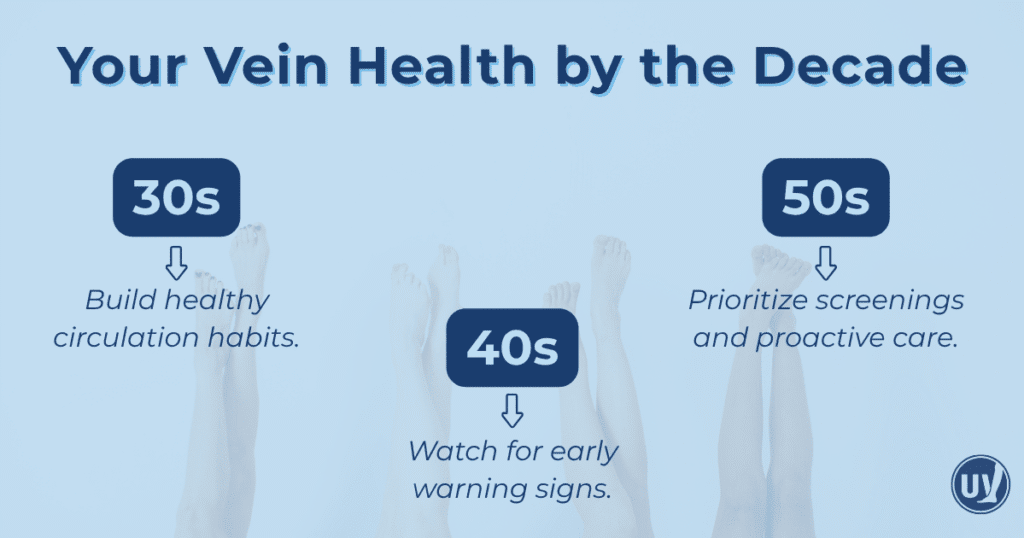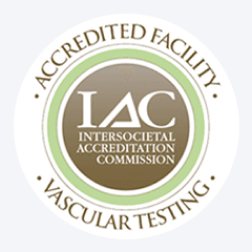Contents
- Why Vein Health Matters at Every Age
- Vein Health in Your 30s: Build a Strong Foundation
- Vein Health in Your 40s: Watch for Early Warning Signs
- Vein Health in Your 50s: Prioritize Checkups and Care
- Common Risk Factors for Vein Issues
- Signs It’s Time to See a Vein Specialist
- Supporting Vein Health Through Lifestyle and Nutrition
- Treatment Options for Vein Conditions
- Take Charge of Your Vein Health with Expert Care
- Frequently Asked Questions
Vein health is often overlooked until discomfort or visible changes appear. But your veins play a vital role in your overall well-being, helping blood circulate efficiently throughout the body. As you move through your 30s, 40s, and 50s, paying attention to your vein health becomes increasingly important.
This guide walks you through what to watch for at each stage of life, from early prevention to recognizing warning signs and knowing when to see a specialist. You’ll also learn how lifestyle habits, nutrition, and proactive care can help you maintain strong, healthy veins at every age.
Why Vein Health Matters at Every Age
Healthy veins support better circulation, deliver oxygen and nutrients, and keep swelling and fatigue at bay. When vein function declines, blood can pool in the legs, causing discomfort and sometimes leading to more serious conditions like deep vein thrombosis (DVT).
Taking care of your veins helps you:
- Improve circulation for more energy and mobility
- Reduce the risk of complications like blood clots
- Enhance comfort and confidence in daily life
No matter your age, understanding vein health helps you make informed decisions and take preventive action before issues progress.
Vein Health in Your 30s: Build a Strong Foundation
Your 30s are the perfect time to establish lifelong habits that promote healthy circulation. Even if you haven’t noticed symptoms yet, small choices now make a big difference later.
Stay active with regular exercise, especially activities like walking, swimming, or cycling that strengthen leg muscles and improve blood flow. Eat a balanced diet rich in fiber and antioxidants, and stay hydrated to support vascular function.
If your work involves sitting or standing for long periods, take short movement breaks to keep blood flowing. Simple adjustments like stretching, walking between meetings, or flexing your calves at your desk can help protect your veins.
Building a foundation of good habits now sets you up for healthier veins in the decades to come.
Vein Health in Your 40s: Watch for Early Warning Signs
In your 40s, you may begin to notice subtle changes in your veins or experience mild symptoms such as leg heaviness, fatigue, or swelling after long days. Visible veins may appear, which could signal the start of varicose or spider veins.
Don’t ignore these early signs or assume they’re just part of aging. Pay attention to how your legs feel at the end of the day and whether symptoms persist.
If swelling, discomfort, or visible veins continue, it’s a good idea to schedule an evaluation with a vein specialist. Early detection and simple treatments can prevent problems from worsening and help you maintain good circulation.
Vein Health in Your 50s: Prioritize Checkups and Care
By your 50s, your veins have been working hard for decades, and natural changes in elasticity, muscle tone, and hormone levels can increase your risk for vein issues. This is the time to be proactive about monitoring and care.
Regular checkups with a vein specialist can help identify underlying circulation issues before they progress. Your provider may recommend noninvasive treatments or lifestyle adjustments to improve blood flow and relieve symptoms.
Continue staying active, elevate your legs when resting, and avoid sitting or standing in one position for too long. These simple habits help reduce strain on your veins and support healthy circulation well into later life.

Common Risk Factors for Vein Issues
Some factors that influence vein health are outside your control, like genetics or age. However, many others can be managed through awareness and lifestyle changes.
Risk factors include:
- A family history of vein problems
- Prolonged sitting or standing at work
- Limited physical activity
- Weight fluctuations or pregnancy
- Hormonal changes and aging
Knowing your risks can help you make mindful choices and discuss preventive options with your healthcare provider.
Signs It’s Time to See a Vein Specialist
You don’t have to wait for severe discomfort to seek help. If you notice any of the following, it may be time to book a consultation:
- Persistent swelling in your legs or ankles
- Aching, heaviness, or fatigue that worsens after standing
- Visible varicose or spider veins
- Skin discoloration or changes near your ankles
Addressing these symptoms early can prevent more serious complications and improve your comfort and mobility.
Supporting Vein Health Through Lifestyle and Nutrition
Everyday habits make a big difference in how well your veins function. Stay active, maintain a balanced diet, and keep your legs moving throughout the day.
Focus on foods rich in antioxidants and vitamin C, such as citrus fruits, leafy greens, and berries, which strengthen blood vessel walls. Omega-3 fatty acids found in fish and nuts help reduce inflammation and support circulation.
Always consult with your doctor before adding supplements like horse chestnut extract or vitamin E to your routine.
Treatment Options for Vein Conditions
If lifestyle changes aren’t enough, modern vein treatments are more effective and minimally invasive than ever. Depending on your needs, your specialist might recommend:
- Sclerotherapy: A quick in-office injection to close small veins.
- Endovenous ablation: A minimally invasive procedure that seals off damaged veins.
- Laser therapy: A light-based treatment that reduces the appearance of veins.
Your provider will help determine which treatment is best for your symptoms and lifestyle.
Take Charge of Your Vein Health with Expert Care
Your 30s, 40s, and 50s are all opportunities to invest in your vein health — not just react to changes, but prevent them. By combining smart lifestyle choices with professional guidance, you can keep your circulation strong and your legs feeling their best.
If you’ve noticed symptoms or simply want to understand your vein health better, schedule a consultation with United Vein & Vascular Centers. Our specialists use advanced diagnostics and personalized care to help you stay proactive, comfortable, and confident at every stage of life.
Frequently Asked Questions
Your 30s are when circulation habits begin to influence long-term vein function. Staying active, maintaining a healthy weight, and monitoring early signs of swelling or fatigue can help prevent issues before they start.
Many people begin to notice heaviness, swelling, or visible veins in their legs. These symptoms often appear mild but can signal underlying circulation issues that are easier to treat early.
If you have symptoms like leg discomfort, visible veins, or a family history of vein disease, consider an annual evaluation. Routine checkups can help detect and manage vein issues before they progress.


